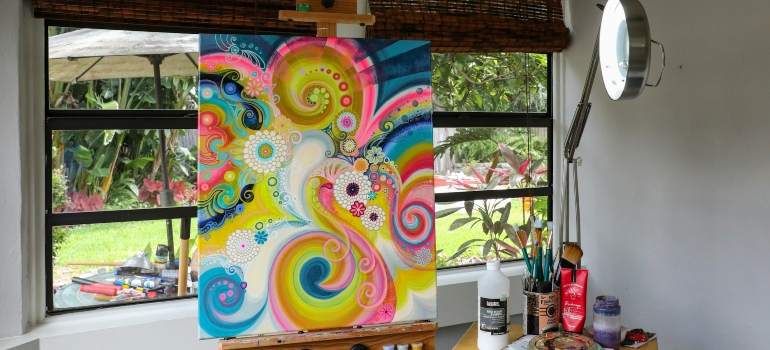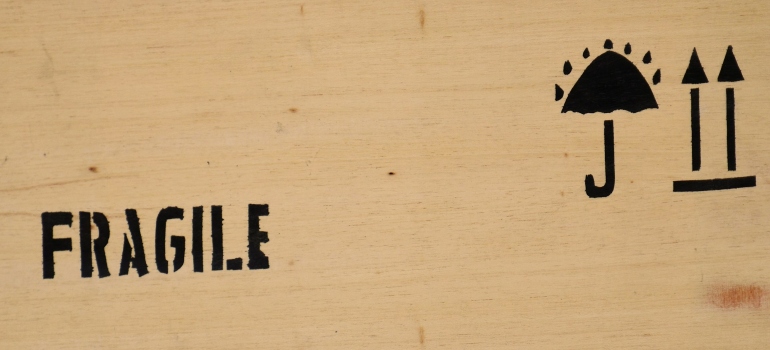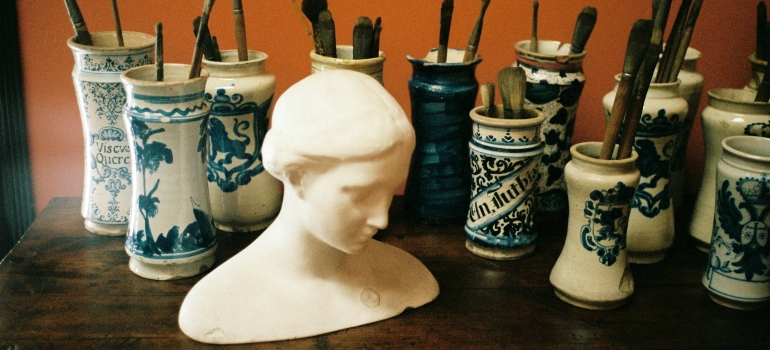Pack Your Artwork for a Move – Pro Guide
Relocation can be exciting, especially when you bring cherished artworks that add character and beauty to your new home. Properly packing your artwork is crucial to ensure it arrives safely and intact. Careful planning and execution can avoid potential risks and damages during a move, such as scratches, breaks, and exposure to elements. This guide is designed by your trusted Seattle movers to help you prepare art pieces like a pro. We’re providing step-by-step instructions and tips to protect and pack your artwork for a move. Thus, whether relocating across Seattle or to a new city in Washington, you’ll find everything you need to ensure your art arrives in perfect condition.
Preparing for the Move
Detailed inventorying provides you with an accurate valuation, which is essential for insurance purposes, and gives peace of mind knowing the worth of your collection.
Inventory and Appraisal
Before you start packing, it’s crucial to create a detailed inventory of all the artworks you plan to move. This list will help you keep track of each piece and ensure that nothing is left behind. For valuable artwork, it’s wise to get a professional appraisal.
Additionally, take clear, high-resolution photographs of each artwork from multiple angles and create condition reports noting any existing damage or wear. Such careful documentation will be invaluable if you need to file an insurance claim or prove the condition of your items before the move.
Gathering Supplies
Having the right supplies on hand is essential for protecting your artwork during the move. You’ll need basic packing materials that will help cushion and secure your pieces:
- Bubble Wrap: Perfect for cushioning fragile items.
- Packing Paper: Ideal for wrapping and padding.
- Cardboard: Use for creating custom supports and barriers.
- Tape: Secure your packing materials firmly.
Specialized Supplies for Artwork
- Glassine Paper: Protects art from moisture and smudging.
- Corner Protectors: Shields frame corners from damage.
- Artist’s Tape: Safe for use on artworks and frames.
Tools Needed
- Measuring Tape: Ensure boxes and crates fit your artwork precisely.
- Scissors: For cutting materials to size.
- Gloves: Wear gloves to avoid transferring oils and dirt to your art.
Specialized supplies can offer extra protection, and finally, you must make sure you have the necessary tools to facilitate the packing process.

Packing Techniques for Different Types of Art
Different types of art require specific methods to protect them from damage during transit. Here, we will discuss the best practices for packing framed paintings and prints, unframed artworks and canvases, and sculptures and 3D artworks.
Framed Paintings and Prints
Framed paintings and prints are often fragile and need careful handling to avoid damage. Start by gently cleaning the frames with a soft cloth to remove dust and dirt. Handling frames with care is crucial to avoid scratching or damaging the surface.
To protect glass surfaces, apply painter’s tape in an “X” shape across the glass. This step helps prevent the glass from shattering and causing further damage. Next, attach corner protectors to each corner of the frame to safeguard against knocks and bumps. Wrap the entire piece in bubble wrap, ensuring complete coverage and securing it with tape. Finally, choose the right box size or custom shipping crates Seattle residents use for framed artwork. The box or crate should fit snugly to prevent movement during the move.
Unframed Artwork and Canvases
Unframed artworks and canvases require a different approach to ensure their safety. For unframed prints and canvases, rolling them carefully is a good method. Place a sheet of glassine paper between the artwork and the outer layer to protect against moisture and smudging. Secure the rolled artwork with artist’s tape and place it in a sturdy tube for added protection.
Using glassine paper and tubes provides a solid defense against damage during transit. For larger unframed canvases that cannot be rolled, consider alternative methods. One effective technique is to create a protective sandwich using bubble wrap and cardboard sheets. This method keeps the artwork flat and cushioned, reducing the risk of creases and tears.
Sculptures and 3D Artworks
Due to their shapes and materials, sculptures and 3D artworks often present unique challenges. To properly pack your artwork for a move, assess each sculpture’s fragility and weight to determine the best packing method. Delicate and heavy pieces will require assistance from heavy equipment movers and more extensive protection.
For wrapping, use multiple layers of bubble wrap, paying extra attention to delicate areas. Foam padding can be used to fill gaps and provide additional cushioning. Custom crating is highly recommended for large or irregularly shaped sculptures. These crates are built to the exact dimensions of your artwork, ensuring a secure fit and maximum protection during the move. Custom crates also offer stability and prevent movement that could lead to damage.
Special Considerations When You Pack Your Artwork for a Move
Moving artwork requires extra attention to detail to ensure the safety of fragile and valuable pieces. Beyond basic packing techniques, handling and transportation considerations play a crucial role in protecting your art during a move.
Labeling and Marking Fragile Items
Clearly, labeling and marking boxes containing fragile items is critical. Use bold, visible markers to indicate “FRAGILE” on all sides of the box. Adding specific instructions like “This Side Up” or “Handle with Care” can further guide movers and reduce the risk of mishandling.

Best Practices for Lifting and Moving
When lifting and moving artwork, always use proper techniques to avoid damage. For heavy or large pieces, it’s best to have at least two people lifting. Bend at the knees, not the waist, to keep the item close to your body and ensure a firm grip. Avoid twisting your body while carrying art to prevent accidents. Use dollies or hand trucks to transport heavy pieces over longer distances.
Using Moving Blankets and Padding in the Vehicle
Once packed, securing your artwork in the moving vehicle is essential. Use moving blankets to wrap and cushion large pieces, providing an extra layer of protection against vibrations and impacts. Position your artwork upright, and never stack heavy items on top of it. Padding the vehicle walls and floor can further absorb shocks and prevent shifting during transit.
Importance of Temperature and Humidity Control
Artwork is highly sensitive to temperature and humidity fluctuations, which can cause warping, cracking, and other forms of deterioration. To protect your pieces, maintain a stable environment with controlled temperature and humidity levels throughout the move. Ideally, keep the temperature between 65-75°F and relative humidity between 40-50%.
Temporary Storage Solutions if Needed
If your move involves temporary storage, ensure the facility offers climate-controlled units. Standard storage units may expose your art to harmful conditions, leading to potential damage. Climate-controlled storage maintains consistent temperature and humidity levels, safeguarding your pieces until they reach their final destination.
Selecting Climate-Controlled Moving Trucks
Once you pack your artwork for a move, consider hiring a moving company that offers climate-controlled trucks. These trucks are equipped to maintain a stable environment, preventing exposure to extreme temperatures or moisture during the move. While this may add to the cost, it is a worthwhile investment for the protection of valuable and sensitive pieces.
Importance of Professional Help and Insurance
Relocating valuable artwork can be a challenge for many reasons, and sometimes, enlisting the help of HB move management professionals and securing appropriate insurance is the best way to ensure a smooth and secure move. Hence, here are some valuable insights into when to hire professional movers, how to select a reputable company, and the essentials of ensuring your art during transit.
When to Consider Hiring Professionals
Hiring professional movers is advisable if you own high-value, fragile, or large artworks that require specialized handling. Professionals have the expertise, equipment, and experience to transport your art safely. Consider professional help if you have an extensive collection, lack the necessary packing materials, or if the logistics of the move are complex.
How to Choose a Reputable Art Moving Company
Selecting the right art moving company involves thorough research. Look for companies with specific experience in handling and transporting artwork. Check their credentials, such as memberships in professional organizations like the American Moving & Storage Association (AMSA). Read reviews and testimonials from previous clients to gauge their reliability and quality of service.

Questions to Ask Potential Movers
When interviewing potential movers, it’s important to gather as much information as possible to ensure they can meet your specific needs. Ask the following questions to assess their suitability for handling your valuable artwork:
- Do you specialize in moving artwork?
- What specific packing and crating methods and materials do you use to protect art during a move?
- Can you provide references from previous clients who had similar moving needs?
- Are your employees trained in handling and packing art?
- Do you offer climate-controlled moving trucks?
- What type of insurance coverage do you provide, and what are the coverage limits?
Asking these questions matters because it helps you gauge the mover’s expertise, reliability, and commitment to protecting your valuable pieces. Familiarizing yourself with their processes and safeguards will give you confidence that your artwork will be handled with the utmost care.
Insurance for Art in Transit
Art in transit insurance is designed to protect your artwork from loss or damage during a move. There are several types of policies available:
- All-Risk Coverage: Offers the broadest protection against various risks, including damage, theft, and loss.
- Total Loss Coverage: It only covers the complete loss of the artwork, not partial damages.
- Named Perils Coverage: Covers specific risks explicitly listed in the policy, such as fire or natural disasters.
Knowing these different types of insurance policies is necessary because it allows you to select the right level of coverage for your needs. Understanding these options ensures that your artwork is adequately protected based on its value and your specific concerns, giving you peace of mind during the move.
How to Document and File Claims
Proper documentation is essential for filing an insurance claim. Ensure you have:
- An inventory list of all artworks being moved
- High-resolution photographs of each piece, taken before packing
- Detailed condition reports describing the state of each artwork prior to the move
- Receipts for packing materials and services used
- Written appraisals for valuable pieces
In the event of damage or loss, file a claim promptly by contacting your insurance provider. Provide all necessary documentation, including the inventory list, photographs, condition reports, and a detailed description of the incident.
Understanding Coverage Limits and Exclusions
When choosing an insurance policy, carefully review the coverage limits and exclusions. Coverage limits determine the maximum amount the insurer will pay for a claim, so ensure these limits match the value of your artwork. Exclusions specify what is not covered by the policy, such as damage caused by improper packing or certain natural disasters. Going through these details before you even start to pack your artwork for a move will help you select a policy that offers comprehensive protection for your collection.
Unpacking and Setting Up in the New Location
Unpacking your artwork requires just as much care and attention as packing it. Start by inspecting each piece upon arrival. Check for any signs of damage, such as cracks, tears, or discoloration, and compare the condition to your pre-move photographs and condition reports. This immediate inspection is crucial for filing any potential insurance claims.

When unpacking, use techniques that minimize the risk of damage. Work slowly and carefully, removing packing materials layer by layer. Avoid using sharp objects that might scratch or puncture the artwork. The right environment helps prevent accidental damage and provides ample space to maneuver.
Re-Hanging and Displaying Art
Choosing the right spot for your artwork in your new location is essential for both aesthetic and preservation purposes. Consider factors like lighting, humidity, and temperature. Avoid hanging art in direct sunlight or near heat sources, as these can cause fading and other damage over time. Rooms with stable climate conditions are ideal for maintaining the integrity of your pieces.
Having the proper tools and hardware for hanging your artwork is crucial for ensuring its stability and security. Use wall anchors and screws that are appropriate for the weight and size of your art. A level and measuring tape can help you achieve precise placement. For heavier pieces, consider using professional-grade hanging systems that distribute weight more evenly and reduce strain on the wall.
Finally, double-check that all hardware is firmly installed and that the artwork is securely hung to ensure stability and security on walls. Regularly inspect the hanging hardware and the condition of the wall to address any potential issues before they become problems. Following all these steps after you pack your artwork for a move will help keep it safely displayed later, enhancing the beauty of your new home.
Why Choose Us
History
Hansen Bros. Moving & Storage is locally owned and operated by the same family for four generations, since 1890. We have a well-established reputation for service quality and reliability with a high percentage of repeat household and commercial clients.
Professionalism
We’re a certified ProMover by the American Moving and Storage Association with A+ rating with the Better Business Bureau, voted “Best in Western Washington” in 2009 and from 2011 to 2016 by KING5. Our company is fully licensed and insured and member of WMC and AMSA.
Value
Hansen Bros. Moving & Storage provide free, no-obligation in-home estimate and competitive rates, including low minimum rates for shipments moving under 300 miles. We’ve set a refund policy for unused packing materials and three Puget Sound locations to help clients save on travel fee costs.



